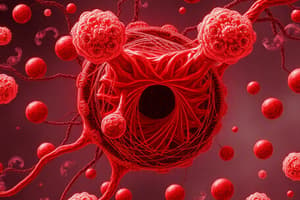Podcast
Questions and Answers
Which component of blood accounts for the majority of its volume?
Which component of blood accounts for the majority of its volume?
- Erythrocytes
- Leukocytes
- Plasma (correct)
- Platelets
What is the main function of erythrocytes?
What is the main function of erythrocytes?
- Regulate blood clotting
- Transport oxygen (correct)
- Transport carbon dioxide
- Protect against pathogens
Which of the following correctly describes the ABO blood group types?
Which of the following correctly describes the ABO blood group types?
- Type B can receive blood from type O. (correct)
- Type AB can only receive blood from type A and type B.
- Type O is known as the universal recipient.
- Type A has both antigens A and B.
Which of the following statements about the dorsal body cavity is true?
Which of the following statements about the dorsal body cavity is true?
What best defines the anatomical position?
What best defines the anatomical position?
Flashcards are hidden until you start studying
Study Notes
Blood Composition
- Blood is the only fluid tissue in the human body.
- Blood is composed of formed elements (living cells) and plasma (non-living fluid matrix).
- Formed elements make up 45% of blood, while plasma makes up 55%.
- Erythrocytes (red blood cells) constitute 45% of blood and are responsible for oxygen transport and carbon dioxide transport.
- Leukocytes (white blood cells) and platelets make up less than 1% of blood.
Erythrocytes
- There are 4-6 million erythrocytes per cubic millimeter of blood.
Blood Groups
- The presence of A and B antigens on red blood cells determines blood type.
- Individuals with both A and B antigens are type AB.
- Individuals with only A antigen are type A.
- Individuals with only B antigen are type B.
- Individuals lacking both A and B antigens are type O.
Blood Transfusions
- Type AB blood can receive blood from all blood types (A, B, AB, and O).
- Type AB is considered the "universal recipient".
- Type B blood can receive blood from B and O blood types.
- Type A blood can receive blood from A and O blood types.
- Type O blood can only receive blood from type O.
- Type O blood is considered the "universal donor".
Anatomical Position
- The anatomical position is a standard reference point for the human body.
- This position assumes the body is standing erect with:
- Feet parallel
- Arms hanging at the sides
- Palms facing forward
- Thumbs pointing away from the body.
Body Cavities
-
The body has two main cavities: dorsal and ventral.
-
The dorsal cavity is divided into two subdivisions:
- Cranial Cavity (contains the brain)
- Spinal Cavity (contains the spinal cord)
-
The ventral cavity is divided into two subdivisions separated by the diaphragm:
- Thoracic Cavity (contains the heart and lungs)
- Abdominopelvic Cavity (contains the stomach, liver, spleen, intestines, kidneys, and pancreas)
Studying That Suits You
Use AI to generate personalized quizzes and flashcards to suit your learning preferences.




